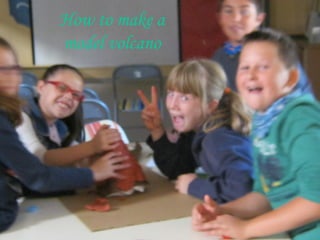Report
Share

Recommended
Recommended
More Related Content
What's hot
What's hot (8)
Similar to Simulating a volcanic eruption
Similar to Simulating a volcanic eruption (20)
List out the chemical reactions you observe in your surroundings 

List out the chemical reactions you observe in your surroundings
More from vcabani
More from vcabani (20)
Información general para reunon padres Educación Fisica 6(1)

Información general para reunon padres Educación Fisica 6(1)
Simulating a volcanic eruption
- 1. How to make a model volcano
- 2. Materials A plastic bottle, 33 cl. Two small glasses of water. A small glass of vinegar. Baking soda. A funnel . A piece of card or cardboard. Plasticine in different colours. White glue.
- 3. Make a cone with a piece of card and cut off the tip.
- 4. Place the plastic bottle inside the cone.
- 5. Glue the bottle and the cone onto the cardboard.
- 6. Cover the cone with plasticine, using different colours.
- 7. Leave the top of the volcano open.
- 8. Use the funnel to pour the water and the vinegar into the botle.
- 9. Add a spoonful of baking soda and watch what happen.
- 11. How does it work? A Volcano is produced over thousands of years as heat a pressure build up. That aspect of a volcano is very difficult to recreate in a class experiment. However this volcano will give you an idea of what it might look like when a volcano erupts flowing lava. This is a chemical reaction: The baking soda is sodium bicarbonate. The vinegar is weak acetic acid. The two chemicals mix together to form carbon dioxide gas. Gases and molten rock escape from a real volcano in much the same way as the carbon dioxide and water- based lava are forced out of the model volcano. You can recharge the volcano by adding more baking soda and vinegar so you can have as many eruptions as you like.
- 12. •I hope you have enjoyed learning how to make a baking soda and vinegar volcano.